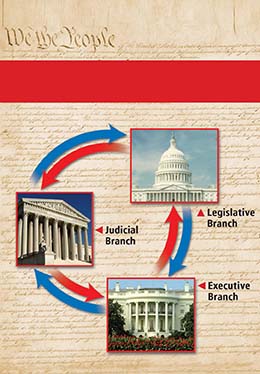American Issues  Connector: Checks and Balances
Connector: Checks and Balances
TRACK THE ISSUE
![]() Does any branch of the federal government have too much power?
Does any branch of the federal government have too much power?
Our system of checks and balances is meant to prevent any branch of government from becoming too powerful. Yet at times the balance of power between the executive, legislative, and judicial branches has shifted. Use the timeline below to explore this enduring issue.
-
1803 Marbury v. Madison
John Marshall affirms Supreme Court’s right of judicial review.
-
1830s Jackson Presidency
Andrew Jackson increases executive power.
-
1868 Johnson Impeachment
Congress tries to remove President Andrew Johnson from office.
-
1930s New Deal
Franklin D. Roosevelt boosts presidential power to fight the depression.
-
1960s Warren Court
Supreme Court under Earl Warren becomes a force for social reform.
-
1973 War Powers Act
Congress limits the President’s power to wage war.
-
2000s War on Terrorism
Congress increases executive branch powers to combat terrorism.

Ticket to Andrew Johnson’s trial
Imbalance of Power? During the administration of President George W. Bush, much debate focused on the relative powers of the President and Congress.
“I do have the view that over the years there had been an erosion of presidential power…. I served in the Congress for 10 years. I’ve got enormous regard for the other body … but … the President of the United States needs to have his constitutional powers unimpaired, if you will, in terms of the conduct of national security policy.”
—Vice President Richard Cheney, December 20, 2005
“During the early years of the post– World War II era, power was relatively well-balanced … but major shifts … have made Congress much weaker and the President dangerously stronger…. The Bush presidency has attained a level of power over Congress that undermines sound democratic governance.”
—Walter Williams, Seattle Times, May 2004
 TRANSFER Activities
TRANSFER Activities
- Compare When does Vice President Cheney feel the President should have more power? Why would Walter Williams disagree?
- Analyze How did the administration of President Andrew Johnson reflect a similar power struggle?
- Transfer Use the following Web site to see a video, try a WebQuest, and write in your journal. Web Code: neh-7202





